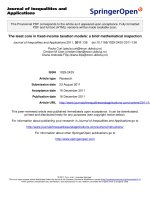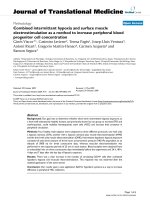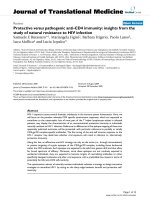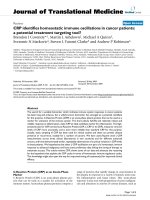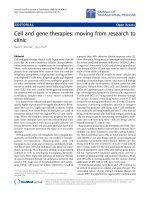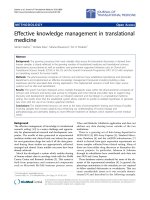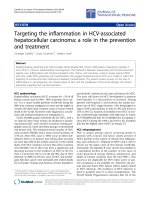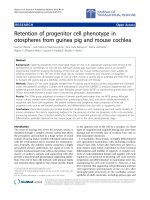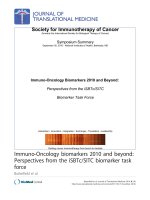báo cáo hóa học:" HIV/AIDS-Related Knowledge Among Malaysian Young Adults: Findings From a Nationwide Survey" pdf
Bạn đang xem bản rút gọn của tài liệu. Xem và tải ngay bản đầy đủ của tài liệu tại đây (624.47 KB, 9 trang )
BioMed Central
Open Access
Page 1 of 9
(page number not for citation purposes)
Journal of the International AIDS
Society
Research article
HIV/AIDS-Related Knowledge Among Malaysian Young
Adults: Findings From a Nationwide Survey
Li-Ping Wong*
1
, Caroline-Kwong Leng Chin
1
, Wah-Yun Low
1
and
Nasruddin Jaafar
2
Address:
1
Health Research Development Unit (HeRDU), Faculty of Medicine, University of Malaya, 50603, Kuala Lumpur, Malaysia and
2
Department of Community Dentistry, Faculty of Dentistry, University of Malaya, 50603, Kuala Lumpur, Malaysia
Email: Li-Ping Wong* -
* Corresponding author
Abstract
Purpose: HIV/AIDS poses a serious threat to young people, both in Malaysia and throughout the
world. A nationwide cross-sectional survey was conducted to assess the knowledge, attitudes, and
beliefs about HIV/AIDS among the Malaysian public. This article reports the findings of knowledge
about HIV/AIDS among young adults.
Methods: A total of 1075 young adult respondents aged 1524 years participated in this survey.
The response rate was 82.2%.
Results: The data indicated that HIV/AIDS knowledge among the respondents was moderate, with
a mean knowledge score of 20.1 out of 32 points. The great majority had adequate knowledge of
the major routes of HIV transmission, but fewer were aware of other modes of transmission, such
as tattooing and piercing, sharing personal items, and breast-feeding from an infected mother. The
great majority knew that HIV is not transmitted by mosquito bites, sharing meals, casual contact,
and using public swimming pools and toilets.
Conclusion: Misconceptions about HIV/AIDS exist although generally knowledge on HIV/AIDS
transmission and prevention was accurate. Education and intervention programs are needed to
increase the level of knowledge and awareness of HIV/AIDS. The findings have important
implications for the development of primary HIV/AIDS prevention programs for young adults in
Malaysia.
Introduction
Globally, young people aged 1524 years account for about
40% of new HIV infections,[1] and this is true in Malaysia,
where HIV infections occur primarily among young peo-
ple. The trend among adolescents and young adults
towards high-risk behavior coupled with insufficient edu-
cation are the primary reasons for the increase in transmis-
sion of HIV.[1,2] A worrisome aspect of this epidemic is
that HIV/AIDS affects Malaysians in their prime produc-
tive years. Malaysia's young people are assets in the devel-
opment of the country, and this epidemic results in a
drain on human resources in this most economically-pro-
ductive portion of the population.[3]
The HIV/AIDS epidemic in Malaysia has emerged as an
important health problem since the first HIV case was
detected in 1986.[4] Since then, according to the Malay-
sian AIDS Council Resource Center, the cumulative
number of HIV infections up to June 2007 amounted to a
total of 78,784.[5] Particularly alarming is the fact that the
Published: 24 June 2008
Journal of the International AIDS Society 2008, 10:148
This article is available from: />Journal of the International AIDS Society 2008, 10:148 />Page 2 of 9
(page number not for citation purposes)
HIV infection rate and AIDS cases are showing a rapid
increase among young people. In young people aged less
than 30 years, there were 20,330 HIV infections and 1818
AIDS cases recorded in 2002. In 2005, the number
increased to 26,810 and 2546, respectively. Up to June
2007, a total of 29,269 HIV infections and 2974 AIDS
cases were reported in Malaysians below the age of 30
years.[5]
Malaysia is a moderate Islamic country with the majority
of Muslim Malays and other ethnicities (Chinese and
Indian) living together with the freedom to practice their
religion and observe other cultural practices. Like many
Islamic societies, issues dealing with sex and sexually
transmitted infections (STIs) are seen as taboo and sensi-
tive, and therefore are not discussed openly.[6-8] Despite
the domination of conservative and traditional values in
Malaysia, adolescents date and many engage in unsafe
sexual intercourse.[9] The incidence of adolescents engag-
ing in sexual intercourse also increases with age.[10,11]
What is more alarming is that most sexual encounters are
unsafe, with no protection against STI and unwanted
pregnancy.[12] There is no doubt that young people are at
greater risk of acquiring STIs, particularly HIV/AIDS, than
other age groups.
With no specific cure for HIV/AIDS, preventive measures
based on information and education programs remain
crucial for tackling HIV/AIDS and its associated prob-
lems.[13] Thus, communication and intervention strate-
gies play important roles in educating the public,
especially the young adult, on the prevention and control
of HIV/AIDS. Previous studies on HIV/AIDS issues were
done based on purposive sampling of populations such as
drug users, healthcare workers, and adolescents[14-16]
and results cannot be generalized to the population as a
whole. Few published studies are available on the knowl-
edge, attitudes, and beliefs about HIV/AIDS among the
general population in Malaysia.
A nationwide survey was conducted for the Ministry of
Health Malaysia to assess HIV/AIDS-related knowledge,
attitudes, beliefs, and practices among the population
aged 1549 years. The purpose of this survey was to lay
down a baseline measurement to help design education
and intervention strategies related to HIV/AIDS that
would educate the public, raise awareness, and ultimately
decrease the incidence of risk-related behaviors associated
with the spread of HIV. This article reports on the findings
among young respondents aged 1524 years.
Methods
The Nationwide Survey on HIV/AIDS Knowledge, Atti-
tudes and Risk Behavior was conducted in 2006 for the
Health Education Division, Ministry of Health (MOH)
Malaysia by the University of Malaya. The main objective
of the survey was to assess the knowledge, attitudes, and
risk behaviors related to HIV/AIDS among people aged 15
to 49 years. The data collection was carried out between
the months of June and July 2006.
Study Design
A cross-sectional design was used in the survey. Respond-
ents were interviewed face-to-face using a structured ques-
tionnaire, and questions on risk behavior were self-
administered.
Sample Selection
Multistage random sampling design with probability pro-
portional to size was used in the survey. The studies were
conducted in 4 states from Peninsular Malaysia and both
states in East Malaysia. The 4 states from Peninsular
Malaysia were randomly selected by dividing the penin-
sula into 4 zones: North, South, East and West. In each
zone, a state was randomly chosen. Then a district was
randomly selected from the 6 selected states (Figure 1). A
district is geopolitically divided into several mukims or sec-
tions. Therefore, a mukim was randomly selected from a
chosen district. Finally, an urban and a rural area were
selected randomly from a mukim. At the household level,
stratified random selection based on major ethnicity
(Malay, Chinese, and Indian; ratio of 5:4:1, respectively)
and sex (male to female ratio of 1.03) was carried out.
Households were selected randomly from the areas cho-
sen in a mukim. If a household had more than 1 eligible
The selected 6 districts where data were collectedFigure 1
The selected 6 districts where data were collected.
THAILAND
SINGAPORE
Timur Laut
Gua Musang
MALAYSIA
BORNEO
BRUNEI
Kota Kinabalu
Kuching
MALAYSIA
Tioman
NN
INDONESIA
(Kalimantan)
Kotabalu
National Park
Kuantan
Seremban
NEGERI
SEMBILAN
Kota Kinabalu
SABAH
MALAYSIA
SULU SEA
Gombak
Batu Pahat
SARAWAK
Miri
Kuching
MELAKA
PAHANG
Cameron
Highlands
TERENGGANU
Kota Bahru
Alur Setar
Kangar
KELANTAN
PERAK
Ipoh
KEDAH
PERLIS
George Town
PENANG
LANGKAWI
SELANGOR
SOUTH SEA CHINA
SOUTH CHINA SEA
Malecca
Kuala Lumpur
JOHOR
Johor Bahru
Kuala
Terengganu
Journal of the International AIDS Society 2008, 10:148 />Page 3 of 9
(page number not for citation purposes)
respondent, only two of them from different age genera-
tions were selected. Based on census data,[17] the total
population aged 1549 years in Malaysia was 12,536,500.
The calculated sample size was 2017, using the 95% con-
fidence interval, 80% power, and 0.02 error margins.
However, considering the possibility of questionnaires
being rejected due to incompleteness and nonresponse
from participants, the sample size was increased by an
additional 20%, giving a total sample size of 2420.
Ethical Considerations
The study was conducted after approval had been
obtained from the Medical Ethics Committee, University
Malaya Medical Center, Kuala Lumpur, Malaysia. All par-
ticipants were informed of the objective of the study and
verbal consents were received from the respondents for
interview.
Questionnaire
The questionnaire was developed based on a literature
review of other similar surveys in the region as well as glo-
bally and was reviewed and validated by a panel from the
Ministry of Health. The questionnaires were made availa-
ble in 4 languages (Bahasa Malaysia, English, Mandarin,
and Tamil) and were pilot tested and revised before the
survey.
Knowledge of HIV/AIDS consisted of: (1) several aspects
of general HIV/AIDS knowledge (7 questions), (2) modes
of HIV infection (14 questions), (3) prevention of HIV
infection (6 questions), and (4) HIV testing (5 questions).
Responses were scored 1 if correct and 0 if incorrect or
unanswered. The overall knowledge score was calculated
by adding the scores from each of the 4 sections of the test.
Possible overall knowledge scores ranged from 0 to 32.
The knowledge of availability of HIV/AIDS-related health
services in the country was also queried, whereby
respondents were asked where to seek HIV/AIDS related
testing, treatment, and counseling or advice.
Data Analysis
Statistical Package of Social Science (SPPS Inc.; Chicago,
Illinois) version 13.0 was used for data management and
analyses. Descriptive statistics including frequencies,
means, medians, and standard deviations were performed
to give general descriptions of the data. T-test and ANOVA
were performed to examine differences in knowledge
scores and demographic variables. The level for statistical
significance was set at P < .05. Only significant results
were discussed.
Results
The overall response rate of this survey was 82.2%. The
total number of respondents who completed the survey
questionnaire was 2604, with 1075 respondents aged
1524 years.
Characteristics of Respondents
Of the 1075 young respondents in the sample, about half
were aged 1519 years (Table 1); the mean age was 19.4
years (SD ± 2.8). A majority of the respondents reported
that they were currently working and almost half were still
attending school. About three quarters of the respondents
reported secondary school as their highest education
level. Only about 12% of the respondents were married.
The male to female ratio was 1.34, which was somewhat
higher than the male to female ratio of 1.03 in the general
Malaysian population. A substantial percentage of the
respondents fell in the low and lower-middle income cat-
egories, with incomes below 550 US dollars (USD) per
month.
Knowledge of HIV/AIDS
General HIV/AIDS knowledge
The survey found that 4.3% of respondents (n = 46) had
never heard of HIV/AIDS; most of these individuals (n =
30) were from rural areas and nearly half of these (n = 16)
were students. Of those that had heard of HIV/AIDS (n =
1029), when further asked to define HIV and AIDS, many
(64.9%, n = 668) were unable to correctly differentiate
HIV from AIDS. Misconceptions were still noted relating
to HIV/AIDS, with 13.9% (n = 143) having no idea
whether HIV-positive people could be recognized by their
appearance and 28.7% (n = 295) believing that HIV-pos-
itive people could be so recognized. Surprisingly, 18.1%
(n = 186) believed that there was a cure for AIDS, and only
69.8% (n = 718) reported that HIV/AIDS could not be
cured. Only 50.6% (n = 521) believed early detection
could prolong life. The majority (82.9%, n = 853) knew
about blood-based HIV testing; however, 17.1% (n = 176)
had no knowledge about how a person could be tested for
HIV. Many (80.5%, n = 828) had never heard of anony-
mous HIV testing, which has been made available in the
country.
The mean (± SD) and median of the total correct general
HIV/AIDS knowledge scores of all respondents on a 7-
item test were 4.6 ± 1.4 and 5.0, respectively. The mean
total score among respondents from Peninsular Malaysia
(4.8 ± 1.4) was higher than the score among respondents
from East Malaysia (4.2 ± 1.5, P < .001). Female respond-
ents had a significantly (P < .01) higher total mean score
(4.7 ± 1.4) than male respondents (4.5 ± 1.5). Statistically
significant differences were noted among the ethnic
groups (4.8 ± 1.3, P < .001), with the Malays having the
highest score. Older respondents had significantly higher
scores than younger respondents (4.7 ± 1.3 among those
aged 2024-years vs 4.4 ± 1.5 among those aged 1519-
years, P < .001). Urban respondents had a significantly (P
Journal of the International AIDS Society 2008, 10:148 />Page 4 of 9
(page number not for citation purposes)
< .05) higher mean total score (4.7 ± 1.3) than rural
respondents (4.5 ± 1.5).
Knowledge of modes of transmission
Table 2 shows that, on questions about mode of transmis-
sion, most of the respondents knew that HIV is transmit-
ted via sharing injecting needles with an infected person
(94.8%), having sexual intercourse with an infected per-
son (93.7%), receiving a transfusion of infected blood or
receiving an organ from an infected person (91.9%), hav-
ing sex with multiple sexual partners with unknown HIV
status (91.4%), and from an infected mother to her fetus
(85.6%). Most were also aware that HIV infection is not
transmitted by casual contacts (90.8%), sitting on public
toilets (90.5%), and using a public swimming pool
(89.7%). However, a smaller majority were aware of other
modes of transmission, such as tattooing and piercing
(63.3%), sharing personal items (60.8%), and breast-
feeding from an infected mother (54.8%). Transmission
via breast-feeding was the mode of transmission about
which the highest percentage of respondents (28%) was
"unsure."
The mean (± SD) and median of the total scores on mode
of transmission on a 14-item test were 9.7 ± 2.2 and 10.0,
respectively. Female respondents had a higher mean total
score (10.0 ± 2.2) than male respondents (9.6 ± 2.3) (P <
.01). The mean total score was 10.0 ± 2.1 for the older age
Table 1: Sociodemographic Characteristics (N = 1075)
Characteristics Number of Respondents %
Age
1519 years 549 51.1
2024 years 526 48.9
Sex
Male 616 57.3
Female 459 42.7
Ethnicity
Malay 384 35.7
Chinese 306 28.5
Indian 74 6.9
Others 311 28.9
Religion
Islam 495 46.0
Buddhism 294 27.3
Christian 213 19.8
Hindu 66 6.1
Others 7 0.8
Highest Educational Level
No formal schooling 13 1.2
Primary school 52 4.8
Secondary school 808 75.2
College/University 202 18.8
Currently student
Yes 494 46.0
No 581 54.0
Average household income per month*
less than RM1000 580 54.0
RM1000 RM2000 337 32.3
RM2001 RM3000 87 8.1
RM3001 RM4000 29 2.7
RM4001 RM5000 14 1.3
above RM5000 28 2.6
Marital Status
Not married 946 88.0
Married 128 11.9
Divorced/Widowed 1 0.1
Locality
Urban 514 47.8
Rural 561 52.2
Total 1075 100.0
RM = Ringgit Malaysia.
*1 US dollar = RM3.6
Table 1: Sociodemographic Characteristics (N = 1075) (Continued)
Journal of the International AIDS Society 2008, 10:148 />Page 5 of 9
(page number not for citation purposes)
group (2024 years) and (9.5 ± 2.3) for the younger age
group (1519 years) (P < .001). There were significant dif-
ferences in the scores among people of different ethnici-
ties (10.2 ± 2.0, P < .001), with the Malays having the
highest score, followed by the Chinese and Indians.
Knowledge of HIV prevention
In response to the question asking whether HIV infection
could be prevented, 79.1% of the respondents believed
that it could. As shown in Table 3 , the most well-known
modes of prevention were: (1) to avoid taking drugs, (2)
to not share injecting needles and syringes, and (3) to
have sex with only one faithful uninfected partner. Only
79.5% of the study population knew that HIV/AIDS could
be prevented by using condoms. Some misconceptions
were noted, with 41.9% of respondents believing incor-
rectly that washing the genital area with soap after sexual
intercourse could prevent HIV infection and 36.1%
believing that avoiding touching HIV positive people
could do so, thus indicating an inadequate awareness
about the prevention of HIV/AIDS in our study subjects.
On the whole, the mean (± SD) and median of the total
scores on HIV prevention on a 6-item test were 4.3 ± 1.2
and 4.0, respectively. The mean total score was 4.5 ± 1.2
for the older age group (2024 years) and 4.2 ± 1.2 for the
younger age group (1519 years) (P < .01). There were sig-
nificant differences in the scores among different ethnici-
ties (4.5 ± 1.1, P < .05), with the Malays having the highest
score. Rural respondents had a significantly higher aver-
age mean score than urban respondents (4.4 ± 1.1 vs 4.2
± 1.2, P < .05).
Knowledge of HIV testing
It is interesting to note that the majority of the respond-
ents were aware that blood tests (94.7%), DNA tests
(68.3%), and urine tests (63.0%) can all be used for
detecting HIV infection, but that only 35.1% of the
respondents knew that an oral fluid test can also be used
for testing.
On the whole, the mean (SD) and median of the total
overall knowledge scores (calculated by adding the scores
from each section of the test) were 20.1 (SD = 6.0) and 21,
respectively, out of a total of 32 points. Significant differ-
ences were observed between female and male scores
(20.6 [SD = 5.7] vs 19.7 [SD = 6.1], P < .05). Significantly
higher scores were also shown for older respondents com-
pared with the younger respondents (20.9 [SD = 5.2] for
the older group vs 19.3 [SD = 6.5] for the younger group,
P < .001).
The ANOVA showed that the mean total overall knowl-
edge score was significantly correlated with average
household income (F = 2.65, df = 5, P < .05). As shown in
Figure 2, those from households with higher incomes
were significantly more knowledgeable. Significant differ-
ences were also found between respondents from differ-
ent educational levels (F = 20.45, df = 3, P < .001). The
higher the educational level, the higher the mean score
obtained by the respondents. Differences in mean total
score were also observed among the ethnicities, with
Malays obtaining the highest mean total score (F = 9.201,
df = 3, P < .001).
Knowledge on the availability of healthcare services
Respondents were also queried on their knowledge of the
availability of HIV/AIDS-related health services (HIV/
AIDS testing, HIV-related counseling, and treatment for
HIV/AIDS). When asked about where a person could
obtain HIV/AIDS-related health services, the overwhelm-
ing majority noted that they could obtain HIV testing
(94.6%), HIV-related counseling (91.2%), and treatment
(93.8%) from government hospitals. This shows that the
majority recognized that government health facilities
offer HIV/AIDS-related services. In addition to govern-
ment hospitals, a small minority of respondents thought
that the services were also available at private hospitals
and clinics in the country. Surprisingly, some respondents
thought that traditional or folk healers could also provide
such services (HIV testing [4.5%], HIV counseling [7.0%],
HIV treatment [6.9%]).
Sources of HIV/AIDS Information
The respondents obtained HIV/AIDS-related information
from various sources. Television (95.6%) was by far their
primary source, followed by newspaper (86.1%), radio
(76.6%), and printed material from the Ministry of
Health Malaysia (51.6%). Nearly 40% reported having
received HIV/AIDS-related information from friends and
family, and one-third (33.8%) of the respondents
obtained HIV/AIDS-related information from the Inter-
net. Only 23.3% (n = 397) of the respondents mentioned
PROSTAR (the Healthy Adolescents Without AIDS pro-
gram) as a source of information about HIV/AIDS.
Discussion
Our results provided baseline data on the knowledge, atti-
tudes, and beliefs about HIV/AIDS among the young
adults in Malaysia. The level of general HIV/AIDS knowl-
edge among young Malaysian adults was moderate, as
indicated by a total mean score of general HIV/AIDS
knowledge of 4.6 out of 7 points. The findings indicated
that a majority of the respondents were aware of HIV/
AIDS. However, there is a need for improvement as a con-
siderable percentage incorrectly believed that persons liv-
ing with HIV can be recognized by appearance and that
there is a cure for AIDS. Those who are unaware that an
HIV-infected person may by asymptomatic are more at
risk because they are unaware that they could be infected
by an apparently healthy partner.[18] Likewise, misinfor-
mation concerning a cure for HIV/AIDS should be cor-
Journal of the International AIDS Society 2008, 10:148 />Page 6 of 9
(page number not for citation purposes)
rected as this misconception is also another risk factor for
contracting the disease. We also found that nearly half of
the respondents did not believe that early detection could
prolong life, and the majority had never heard of anony-
mous HIV testing. These findings are comparable to stud-
ies done elsewhere in Asia.[6,19,20]
The data in this study revealed a significant gender differ-
ence in general HIV/AIDS knowledge, with females being
more knowledgeable than males. Gender differences in
AIDS knowledge have been found in other stud-
ies[21,22];however, a study among college students in
China, found males to be more knowledgeable than
females.[23] General HIV/AIDS knowledge also appeared
to vary with other demographic characteristics, with the
highest knowledge among the Malays, those from urban
areas, and the older age group. This finding is consistent
with studies in other countries[23,24] and may reflect dif-
ferences in the level of HIV/AIDS education. Educational
efforts need to be targeted at those who are most misin-
Table 2: Correct Answers on Modes of Transmission
Modes of Transmission Correct Answer Number of Respondents (% Correct Answer)
Sharing needles with HIV-infected person Yes 975 (94.8)
Having sexual intercourse with HIV-infected person Yes 964 (93.7)
Transfusion of HIV-infected blood or receiving HIV-infected organ Yes 945 (91.9)
Having sex with multiple sexual partners with unknown HIV status Yes 940 (91.4)
From an HIV-positive mother to her fetus Yes 880 (85.6)
Sharing personal items such as shaving blades Yes 620 (60.3)
Breast-feeding from an HIV-infected mother Yes 564 (54.8)
Mosquito bites No 484 (47.0)
Kissing an HIV-infected person No 629 (61.1)
Having tattoo or body piercing Yes 651 (63.3)
Sharing a meal with an HIV-infected person No 717 (69.7)
Using a public swimming pool No 923 (89.7)
Sitting on a public toilet No 931 (90.5)
Casual contacts (hugging or touching) with an HIV-infected person No 934 (90.8)
Table 3: Correct Responses on the Prevention of HIV
Prevention Correct Answer Number of Respondents (% Correct Answer)
Avoid taking drugs Yes 737 (90.5)
Do not share needles and syringes Yes 732 (89.9)
Having sex with only one faithful, uninfected partner Yes 692 (85.0)
Use condom during sexual intercourse Yes 647 (79.5)
Wash genital area with soap after sexual intercourse No 473 (58.1)
Avoid touching HIV-positive people No 520 (63.9)
Journal of the International AIDS Society 2008, 10:148 />Page 7 of 9
(page number not for citation purposes)
formed to meet the needs of different populations: (1)
particular age groups, (2) those in different geographical
locations, and (3) different ethnic groups.
Despite the fact that anonymous HIV testing has been
made available to the public, many have not heard of it.
People are more likely to be voluntarily tested for HIV if
the testing is anonymous; for example, a study reported an
increase in the demand for HIV testing once the option of
anonymous testing was provided,[25] and this may even
contribute to early HIV medical care.[26] Hence, the avail-
ability of anonymous HIV testing needs to be emphasized
in the information and education programs directed at
people who are seeking testing.
Consistent with findings in the other Asian coun-
tries[23,27] and the United States,[28,29] the majority of
young people appeared to rely on the public media (tele-
vision, newspapers, and radio) as their primary source of
HIV/AIDS information. Our findings suggest that future
education campaigns on HIV/AIDS would best be con-
ducted via mass media (specifically television, newspa-
pers, and radio). There is overwhelming evidence for the
effectiveness of mass media in raising awareness and
increasing knowledge in developing countries.[30] The
findings of this study are also consistent with other stud-
ies[31] that found that relatively high percentages of
young people did not receive information from family
members and medical professionals. Since the majority of
respondents identified mass media as their main source of
information, it may be one of the most effective channels
for the delivery of HIV/AIDS-related information and edu-
cation efforts.
Although it has been reported that the Ministry of
Health's PROSTAR program (Healthy Living without
AIDS for Youth) significantly increased the level of aware-
ness among the club members,[32] our survey indicated
the majority of young people were not members of PROS-
TAR and many had never heard of it. PROSTAR should
attempt to reach more young people, especially from rural
or hard-to-reach groups to create a future generation of
well-informed youth in relation to HIV/AIDS.
It was observed in this study that although the large
majority of the study population had correct knowledge
of the most common modes of transmission, such as shar-
ing injecting needles and sexual transmission, misconcep-
tions were still held regarding nonsexual routes of
transmission. Belief that HIV could be transmitted by
mosquito bites, sharing meals, casual contact, and using
public swimming pools and toilets still appeared preva-
lent. Mirroring a local study[33] conducted in 1991, this
study showed that the majority of the adolescents inter-
viewed were aware that HIV transmission resulted prima-
rily from high-risk behaviors, such as having unprotected
sex and sharing needles. For these reasons, efforts should
be made to provide accurate information and address
misconceptions about HIV transmission. The erroneous
belief that mosquitoes are vectors for HIV is a quite com-
mon misconception, as has been shown in many other
studies.[34-38] The proportion of respondents that were
aware that HIV/AIDS is not transmitted by mosquito bites
in our study (47.0%) was similar to the results from stud-
ies conducted among Asian-Indian adolescents
(48.0%)[35] and Turkish adolescents (40.3%).[36] Cas-
ual contact and sharing meals were also more likely to be
cited as a way to transmit HIV by those who had less
awareness of the disease, and by those who held more
stigmatizing views toward those living with HIV/AIDS.
Many were also unaware that HIV transmission could
occur from getting a tattoo or through body piercing.
In general, knowledge about HIV prevention was high
among the respondents. Nevertheless, a significant
number of respondents had misconceptions about HIV
prevention methods, in particular the beliefs that washing
the genital area with soap after sexual intercourse and
avoiding touching people living with HIV could prevent
infection. The knowledge of HIV/AIDS prevention in this
study appeared slightly higher among the rural respond-
ents than among urban respondents. Our findings differ
from those of other studies that found the highest knowl-
edge levels among students from urban areas and the low-
Relationship between mean total overall HIV/AIDS knowl-edge score and average household incomeFigure 2
Relationship between mean total overall HIV/AIDS
knowledge score and average household income.
23.0
22.5
22.0
21.5
21.0
20.5
20.0
19.5
19.0
18.5
18.0
< RM 1000 RM 1000 −
RM 2000
Average Household Income Per Month
Mean Knowledge Score
RM 2001−
RM 3000
RM 3001−
RM 4000
RM 4001−
RM 5000
> RM 5000
Journal of the International AIDS Society 2008, 10:148 />Page 8 of 9
(page number not for citation purposes)
est levels among those from rural areas.[23,24]
Nevertheless, this may reflect differences in the level of
HIV/AIDS education or information access in different
regions; HIV/AIDS education should therefore target the
underserved regions.
Although the knowledge of HIV prevention methods is
good, it is important to know whether the young people
are equipped with the necessary life skills to reduce their
vulnerability to HIV infection, such as the ability to nego-
tiate condom use. Elsewhere, many young people do not
have the basic knowledge and skills to prevent themselves
from becoming infected with HIV.[39] Having access to
HIV/AIDS information is not sufficient; young people,
especially adolescents, need to be guided and taught to
incorporate this knowledge into daily life.[40]
The results of our study showed that an overwhelming
majority of the respondents knew where to seek health-
care services related to HIV/AIDS. However, further study
needs to be carried out to ascertain whether young people
have access to the healthcare services provided in all gov-
ernment hospitals and clinics. Reports have shown that in
many developing countries, young peoples' access to STI
and HIV/AIDS healthcare services was insufficient and
remained low compared with that of the adult popula-
tion.[41,42] Nevertheless, knowing where to obtain STI
and HIV/AIDS healthcare services is clearly an essential
first step towards prevention and protection against HIV
infection.
Conclusion
The findings served to illuminate important points about
the knowledge of young Malaysians regarding HIV/AIDS.
There are significant gaps in their knowledge about HIV/
AIDS prevention and transmission along with some mis-
conceptions. Such inadequate knowledge may place
young Malaysians at risk for HIV infection. The data from
this survey could be a useful guide in the development of
campaigns or programs designed to convey accurate infor-
mation about HIV transmission routes and prevention
strategies and to dispel erroneous beliefs about HIV. A
media campaign to increase knowledge and change the
attitudes of Malaysian youth is imperative, with specific
emphasis on the most disadvantaged and neglected seg-
ments of the population.
Authors and Disclosures
L.P. Wong MSc, PhD, has disclosedno relevant financial
relationships.
Caroline Chin KL, BSc, has disclosedno relevant financial
relationships.
W.Y. Low PhD, AFBPsS, Cpsychol, has disclosedno rele-
vant financial relationships.
N. Jaafar MSc, PhD, has disclosedno relevant financial
relationships.
Acknowledgements
The authors gratefully acknowledge the cooperation of the interviewers
and the respondents for their involvement. This study and survey were
made possible through the support and funding of the Health Education
Division, Ministry of Health Malaysia.
References
1. 2006 AIDS Epidemic Update: UNAIDS, December 2006.
[httwww.unaids.org/en/KnowledgeCentre/HIVData/EpiUpdatEpiUp-
dArchive/2006/Default.asp]. Accessed November 28, 2007
2. Trajman A, Belo MT, Teixeira EG, et al.: Knowledge about STD/
AIDS and sexual behavior among high school students in Rio
de Janeiro, Brazil. Cad Saude Publica 2003, 9:127-133.
3. UNFPA: Youth and HIV/AIDS Factsheet: State of World Pop-
ulation 2005. 2005 [www.unfpa.org/swp/2005/presskit/factsheets/
facts_youth.htm]. New York: UNFPA Accessed April 30, 2008
4. Reid G, Kamarulzaman A, Kaur Sran S: Rapid Situation Assess-
ment of Malaysia 2004. Burnet Institute for Harm Reduction 2005
[ />]. Kuala Lumpur:
University Malaya, Department of Medicine, Infectious Disease Unit
Publishers Accessed April 30, 2008
5. Malaysian AIDS Council Resource Center: AIDS in Malaysia. 2006
[ />]. Kuala
Lumpur: Section of AIDS/STD, Department of Public Health, Ministry
of Health Malaysia (MOH) Accessed April 30, 2008
6. Yoo H, Lee SH, Kwon BE, et al.: HIV/AIDS knowledge, attitudes,
related behaviors, and sources of information among Korean
adolescents. J Sch Health 2005, 75:393-399. Abstract
7. Al-Owaish R, Moussa MAA, Anwar A, et al.: Knowledge, attitudes,
beliefs and practices about HIV/AIDS in Kuwait. AIDS Educ
Prev 1999, 11:163-173. Abstract
8. Mahat G, Scoloveno MA: HIV/AIDS knowledge, attitudes and
beliefs among Nepalese adolescents. J Adv Nurs 2006,
53:583-590. Abstract
9. Huang MSL: Case study, Malaysia: communication and advo-
cacy strategies adolescent reproductive and sexual health.
1999 [ />].
Bangkok: UNESCO Principal Regional Office for Asia and the Pacific
Accessed April 30, 2008
10. Zulkifli SN, Low WY, Yusof K: Sexual activities of Malaysia
dolescents. Med J Malaysia 1995, 50:4-10. Abstract
11. Lee LK, Chen PCY, Lee KK, Jagmohni K: Premarital sexual inter-
course among adolescents in Malaysia: a cross-sectional
Malaysian school survey. Singapore Med J 2006, 47:476-481.
Abstract
12. World Health Organization: Sexual and reproductive health of
adolescents and youths in Malaysia: a review of literature
and projects 2005. 2007 [ />9F586241-028D-4DE8-B0A1-B77A34998A5B/0/ASRHmalaysia.pdf].
World Health Organization Accessed April 30, 2008
13. International Institute for Educational Planning/UNESCO: HIV/AIDS
and education: a strategic approach. 2003 [http://
unesdoc.unesco.org/images/0012/001286/128657e.pdf]. Interna-
tional Institute for Educational Planning/UNESCO Accessed April 30,
2008
14. Fauziah MN, Anita S, Sha'ari BN, et al.: HIV-associated risk behav-
ior among drug users at drug rehabilitation centre. Med J
Malaysia 2003, 58:268-272. Abstract
15. Choon SE, Sapiah W, Ismail Z, et al.: Sexual behavior and HIV
knowledge among dermatology cum genitourinary clinic
attendees Johor Bharu Malaysia. Med J Malaysia 1997,
52:318-324. Abstract
16. Ng CJ, Kamal SF: Bridging the gap between adolescent sexual-
ity and HIV risk: the urban Malaysian perspective. Singapore
Med J 2006, 47:482-490. Abstract
Publish with BioMed Central and every
scientist can read your work free of charge
"BioMed Central will be the most significant development for
disseminating the results of biomedical research in our lifetime."
Sir Paul Nurse, Cancer Research UK
Your research papers will be:
available free of charge to the entire biomedical community
peer reviewed and published immediately upon acceptance
cited in PubMed and archived on PubMed Central
yours — you keep the copyright
Submit your manuscript here:
/>BioMedcentral
Journal of the International AIDS Society 2008, 10:148 />Page 9 of 9
(page number not for citation purposes)
17. Population and Housing Census of Malaysia 2000: population
distribution by local authority areas and mukims. Department
of Statistic Malaysia; 2001.
18. Sarker M, Milkowski W, Slanger T, et al.: The role of HIV-related
knowledge and ethnicity in determining HIV risk perception
and willingness to undergo HIV testing among rural women
in Burkina Faso. AIDS Behav 2005, 9:243-249. Abstract
19. Davis C, Noel MB, Chan SF, et al.: Knowledge, attitudes and
behaviors related to HIV and AIDS among Chinese adoles-
cents in Hong Kong. J Adolesc 1988, 21:657-665.
20. Nemato T: HIV/AIDS surveillance and prevention studies in
Japan: summary and recommendations. AIDS Educ Prev 2004,
16(Suppl A):27-42.
21. Hardy AN: National Health Interview Survey Data on adult
knowledge of AIDS in the United States. Public Health Rep
1990, 105:629-634. Abstract
22. Fisher J, Misovich S: Evolution of college students' AIDS-related
behavioral responses, attitudes, knowledge, and fear. AIDS
Educ Prev 1990, 2:323-337.
23. Li XM, Lin CD, Gao ZX, et al.: HIV/AIDS knowledge and the
implications for health promotion programs among Chinese
college students: geographic, gender and age differences.
Health Promotion Int 2004, 19:345-356.
24. Warren C: Geographic variation in AIDS knowledge and atti-
tudes among adolescent girls in Jamaica. AIDS Educ Prev 1999,
11:364-372. Abstract
25. Hamm RH, Louise SA, Van Tuinen M, et al.: Effects of offering
anonymous HIV testing at a central Missouri HIV testing
site. Abstr Search Tools 1999; Natl HIV Prev Conf; August 29-September
1,1999; Atlanta, Ga . (abstract no. 400)
26. Bindman AB, Osmond D, Hecht FM, et al.: Multistate evaluation of
anonymous HIV testing and access to medical care. JAMA
1998, 280:1416-1426. Abstract
27. Tavoosi A, Zaferani A, Enzevaei A, et al.: Knowledge and attitude
towards HIV/AIDS among Iranian students. BMC Public Health
2004, 4:17.
28. DiClemente R, Zorn J, Temoshok L: Adolescents and AIDS: sur-
vey of knowledge, attitudes and beliefs about AIDS in San
Francisco. Am J Public Health 1986, 76:1443-1445. Abstract
29. Marcelin LH, McCoy HV, DiClemente RJ: HIV/AIDS knowledge
and beliefs among Haitian adolescents in Miami-Dade
County, Florida. J HIV AIDS Prev Child Youth 2006, 7:121-138.
Abstract
30. Bertrand JT, O'Reilly K, Denison J, et al.: Systematic review of the
effectiveness of mass communication programs to change
HIV/AIDS-related behaviors in developing countries. Health
Educ Res 2006, 21:567-597. Abstract
31. Svenson LW, Carmel S, Varnhagen CK: A review of the knowl-
edge, attitudes and behaviors of university students concern-
ing HIV/AIDS Int. Health Promotion 1997, 12:61-68.
32. Malaysia achieving the Millennium Development Goals
Report. Malaysia's Millennium Development Goals (MDG)
[www.undp.org.my/uploads/files/MDG6.pdf
]. Accessed September
18, 2007
33. Zulkifli SN, Wong YL: Knowledge, attitudes and beliefs related
to HIV/AIDS among adolescents in Malaysia. Med J Malaysia
2002, 57:3-23.
34. Rind P: Misconceptions about HIV transmission are common
in Kinshasa. Int FamPlann Perspecti 1991, 17:78-79.
35. Bhattacharya G, Cleland C, Holland S: Knowledge about HIV/
AIDS, the perceived risks of infection and sources of infor-
mation of Asian-Indian adolescents born in the USA. AIDS
Care 2000, 12:203-209.
36. Savasar S: Knowledge and attitudes of high school students
about AIDS: a Turkish perspective. Pub Health Nurs 2003,
20:71-79.
37. Maswanya E, Moji K, Aoyagi K, et al.: Knowledge and attitude
towards AIDS among female college students in Nagasaki,
Japan. Health Educ Res 2000, 12:5-11.
38. Petro-Nustas W: University students' knowledge of AIDS. IntJ
Nursi Stud 2000, 37:423-433.
39. Dick B, Ferguson J, eds: Preventing HIV/AIDS in young people:
systematic review of the evidence from developing coun-
tries: UNAIDS interagency task team on HIV and young
people. 2006 [ />WHO_TRS_938_eng.pdf]. World Health Organization Accessed
April 30, 2008
40. Sales JM, Milhausen RR, Diclemente RJ: A decade in review: build-
ing on the experience of past adolescence STI/HIV interven-
tion to optimize future intervention efforts. SexTransm Infect
2006, 82:431-436.
41. WHO, UNAIDS, UNFPA, UNODC, YouthNet: Protecting young
people from HIV and AIDS: the role of health services. 2004
[ />ADH/ISBN_92_4_159247_8.pdf]. Geneva: World Health Organiza-
tion Accessed April 30, 2008
42. UNICEF, UNAIDS, WHO: Young people and HIV/AIDS oppor-
tunity in crisis. 2002 [ />files/pub_youngpeople_hivaids_en.pdf]. New York: UNICEF
Accessed April 30, 2008
